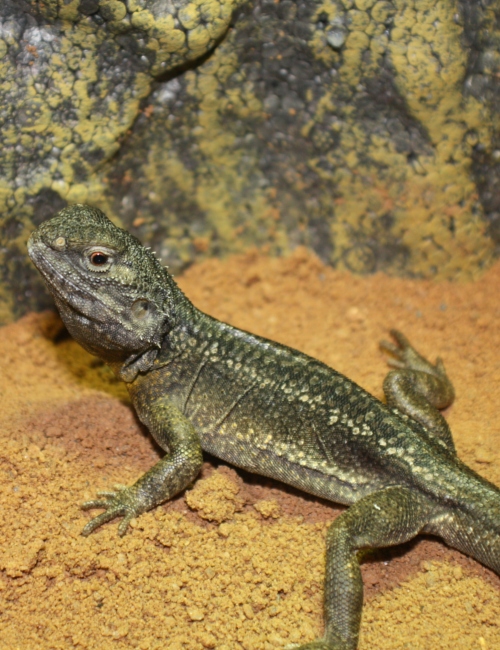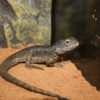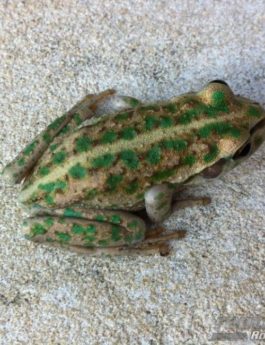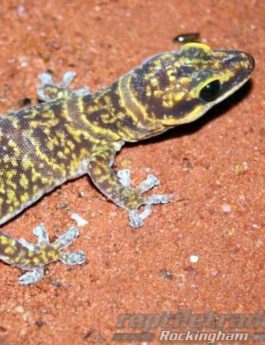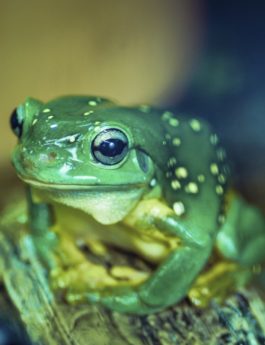The Western Netted Dragon is a small to moderate sized, robust, swift moving lizard. They have a round head with a very blunt snout, short limbs and tail. They have spines on the crest of their head and sides of the neck. Mature males have varying amounts of black ventral colouration, it is common for the male to have irregular red blotches, that turn a deep red when breeding, and a red/orange flush on his chin and throat. Juvenile Western Netted Dragons are often olive grey with dark spots alternating with bands of small white spots, females lose their pale spots and develop a series of elongated dark grey blotches.
The Western Netted Dragon favours heavy, stony soils and can be found under logs and other natural debris, rubbish fallen fence posts and isolated stones and boulders, with or without a short burrow. They also shelter under exfoliating granite and behind the bark of fallen trees. They can be found throughout most of the southern half of WA and northern SA
Terrarium: there are several terrariums of different sizes available, the required size will vary based on number of and age/size of the Netted dragons. Terrariums should be large enough to maintain a correct thermal gradient in ambient air temperatures, this means that the dragon can regulate its body temperature throughout the enclosure. For a single average size mature Netted dragon, we wouldn’t recommend anything smaller than 60x45x60cm (WxDxH), and for a pair of adult dragons we would recommend a terrarium size of 90x45x60cm (WxDxH) as there needs to be enough room for them to chase their food and have their own basking spots.
Lighting & heating: Western Netted Dragons are a ‘Day Active’ lizard, meaning they are Diurnal and therefore require high spectrum UVB lighting as well as an intense basking heat source. There are a number of ways to provide UVB, fluorescent 10.0 spectrum tubes or bulbs will provide UVB, a ‘daylight basking’ heat globe will have to be used in conjunction. A mercury vapour globe will provide intense UVA & UVB light, mercury vapour globes are in our opinion superior to fluorescents as it is a longer lasting globe with more intense UVB output, however they cannot be used with a thermostat so work better with a larger enclosure that will easier maintain a thermal gradient. During the day, you want to achieve a basking ‘Hot Spot’ of 38°C and an air temperature ranging from 35°C in the hot end, and down to 20-25°C in the cool end. A heat rock or heat tile should be provided as tummy heat to help with digestion, this can also be used as a night time heat source. To monitor the temperatures inside the enclosure a thermometer should always be used.
Furnishings: an elevated basking area can be provided using logs, vines or hammocks. Artificial foliage throughout the enclosure will allow the Netted dragon plenty of hiding spots and coverage, a water bowl placed in the cool end, and red sand kept at the correct moister is our recommended substrate.
Food in captivity: Western Netted Dragons will eat mostly crickets, wood roaches and silk worms in captivity as they are primarily insectivores. Some will take to eating an appropriate variety of fruits and vegetables as well as insects. Food items will need to be dusted with calcium and vitamin supplements.
The essentials:
- Terrarium of appropriate size
- High spectrum UVB lighting
- Daytime Basking globe
- Thermometer
- Ground heat
- Water bowl
- Substrate
- Branches/Vines
- Foliage for shelter
- Calcium and vitamin supplements

